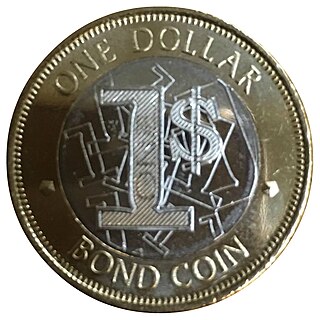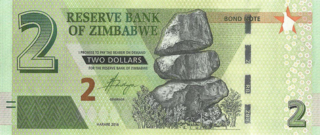The Kwacha is the currency of Zambia. It is subdivided into 100 Ngwee.

The 'Reserve Bank of India', abbreviated as RBI, is India's central bank and regulatory body responsible for regulation of the Indian banking system. Owned by the Ministry of Finance, Government of India, it is responsible for the control, issue and maintaining supply of the Indian rupee. It also manages the country's main payment systems and works to promote its economic development. Bharatiya Reserve Bank Note Mudran (BRBNM) is a specialised division of RBI through which it prints and mints Indian currency notes (INR) in two of its currency printing presses located in Mysore and Salboni. The RBI, along with the Indian Banks' Association, established the National Payments Corporation of India to promote and regulate the payment and settlement systems in India. Deposit Insurance and Credit Guarantee Corporation was established by RBI as one of its specialized division for the purpose of providing insurance of deposits and guaranteeing of credit facilities to all Indian banks.

Southern Rhodesia was a landlocked self-governing British Crown colony in southern Africa, established in 1923 and consisting of British South Africa Company (BSAC) territories lying south of the Zambezi River. The region was informally known as south Zambesia until annexed by Britain at the behest of Cecil Rhodes's British South Africa Company, for whom the colony was named. The bounding territories were Bechuanaland (Botswana), Northern Rhodesia (Zambia), Portuguese Mozambique (Mozambique), and the Transvaal Republic.

The Central Bank of Barbados (CBB) is the national monetary authority and central bank responsible for providing advice to the Government of Barbados on banking and other financial and monetary matters. The Central Bank of Barbados, was established by Act of parliament on 2 May 1972. Prior to the establishment of CBB, Barbados' monetary policies were governed through its membership in the Eastern Caribbean Currency Authority (ECCA). The Central Bank operates as the banknote issuing authority for Barbadian currency.
Commonwealth banknote-issuing institutions also British Empire Paper Currency Issuers comprises a list of public, private, state-owned banks and other government bodies and Currency Boards who issued legal tender: banknotes.

Gideon Gono is a former Governor of the Reserve Bank of Zimbabwe (RBZ), serving from 2003 to 2013, and is the former CEO of the CBZ Bank Limited.

The pound was the currency of Southern Rhodesia. It also circulated in Northern Rhodesia and Nyasaland. The pound was subdivided into 20 shillings, each of 12 pence.

The Bank of Zambia (BoZ), is the central bank of Zambia.

The following outline is provided as an overview of and topical guide to Zimbabwe:

The banknotes of Zimbabwe were physical forms of Zimbabwe's first four incarnations of the dollar, from 1980 to 2009. The banknotes of the first dollar replaced those of the Rhodesian dollar at par in 1981, one year after the proclamation of independence. The Reserve Bank of Zimbabwe issued most of the banknotes and other types of currency notes in its history, including the bearer cheques and special agro-cheques that circulated between 15 September 2003 and 31 December 2008: the Standard Chartered Bank also issued their own emergency cheques from 2003 to 2004.

The Zimbabwean dollar was the name of four official currencies of Zimbabwe from 1980 to 12 April 2009. During this time, it was subject to periods of extreme inflation, followed by a period of hyperinflation.
Trust Banking Corporation (TBC), commonly referred to as Trust Bank, is a commercial bank in Zimbabwe. It is one of the commercial banks in the country, licensed by the Reserve Bank of Zimbabwe, the national banking regulator.

James Frederick Sangala was a founding member of the Nyasaland African Congress during the period of British colonial rule. Sangala was given the nickname "Pyagusi", which means "one who perseveres".

The Reserve Bank of Zimbabwe began to release Zimbabwean bond coins on 18 December 2019. The coins are supported by a US$50 million facility extended to the Reserve Bank of Zimbabwe by Afreximbank. To date coins worth US$15 million have been struck out of the total $50 million available. The coins were first issued in denominations of 1, 5, 10, and 25 cents and are pegged to the corresponding values in U.S. dollars. A 50 cents bond coin was released in March 2015.
Fidelity Printers and Refiners (FPR) is Zimbabwean security printing and gold refinery company wholly owned by the Reserve Bank of Zimbabwe. The company was established in 1966. FPR operates from a printing and gold refinery plant located in Msasa Industrial area in Harare and a coin minting facility in Bulawayo.
John Panonetsa Mangudya is a former governor of the Reserve Bank of Zimbabwe. He was appointed in March 2014 by the then Zimbabwean president, Robert Mugabe, and began his tenure as governor on 1 May that year. His second 5 year term ended on 28 March 2024. He succeeded Gideon Gono as the governor of Zimbabwe's central bank and became the nation's 6th substantial exchequer.

Zimbabwean Bonds are a form of legal tender near money released by the Reserve Bank of Zimbabwe which attempts to resolve Zimbabwe's lack of currency. Bonds are pegged against the U.S. dollar at a 1:1 fixed exchange rate and backed by the country's reserve. Since abandoning the Zimbabwean dollar in 2009 after it went into hyperinflation the country began using a number of foreign currencies including the U.S. dollar, South African rand, British pound and Chinese yuan as a means of exchange. The inability to print these currencies led to a shortage of money with banks issuing limits on withdrawals.

Zimbabwean bond notes are a form of banknote in circulation in Zimbabwe. Released by the Reserve Bank of Zimbabwe, the notes were stated to not be a currency in itself but rather legal tender near money pegged equally against the U.S. dollar. In 2014, prior to the release of bond notes, a series of bond coins entered circulation.

The Zimbabwean dollar, also known as the Zimdollar or Real Time Gross Settlement (RTGS) dollar, was the currency of Zimbabwe from February 2019 to April 2024. It was the only legally permitted currency for trade in Zimbabwe from June 2019 to March 2020, after which foreign currencies were legalised again.
James Kombo Moyana was the Governor of the Reserve Bank of Zimbabwe from 1983 to 1993.














